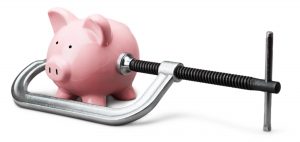Feeling the Squeeze
Everywhere you look these days, prices are up. From small essentials such as fruits, vegetables, eggs, meat, gas and clothing to big-ticket items including cars, housing, utilities and home improvements, consumers are experiencing sticker shock that hasn’t been seen in 40 years. Yet while the average person is just now feeling the squeeze of inflation in their everyday lives, small businesses have been dealing with the challenges for nearly a year and they don’t see relief coming any time soon.
A National Scope
The writing has been on the wall, according to Dr. Sean Snaith, director of the University of Central Florida’s Institute for Economic Forecasting. “While the Russian invasion of Ukraine was one unanticipated event that has had an effect, prior to that we had already been seeing the higher prices for gas and oil, the random shortages caused by supply chain issues, and difficulties in the labor market,” he says. “All of these things have their roots in COVID-19 policies when unprecedented decisions were made to shut down portions of the economy. … The lockdowns disproportionately affected small businesses and lower-income earners. For those who survived, they are faced with higher costs for their supplies—if they can get them—and faced with worker shortages or higher wages to get workers.”
Earlier this month, the Federal Reserve raised its rate 0.25% for the first time since 2018. Snaith says inflation has to be accommodated by monetary policy. “The Fed has kept interest rates extraordinarily low but has also grown its balance sheet from about $800 billion in 2006-07 to around $9 trillion. That puts a lot of liquidity into the economy and I would say that’s analogous to underbrush in a forest being fuel that can feed a fire. The other policies that came due to COVID were the spark that set this burning.”
Snaith says rates will likely continue to increase through the end of the year, possibly into 2023. While it gives the economy a fighting chance against inflation, there won’t be a tremendous amount of relief for the average person, he continues. “Wages have gone up but unfortunately the cost of living has risen faster than pay increases. There might be more dollars in our paycheck but those dollars are able to buy us less than before the raise. … There’s a lot of uncertainty and I think it’s going to be turbulent here for the next six-plus months.”

The Local Impact
Small businesses, the backbone of our economy, were forced to adapt during the pandemic. Now, just as many got back on their feet, inflation has dealt them another blow.
“Many [businesses] streamlined production, services and items they offered. Some became more efficient and profitable. Now we are seeing businesses who haven’t been able to adapt, change their model or just can’t afford to stay open, due to loss in customers and high expenses,” says Andrew Cole, president/CEO of the East Orlando Chamber of Commerce.
The limited workforce remains a concern, and businesses continue to struggle with hiring. Faced with the higher cost of goods and services, as well as payroll, it’s inevitable that costs will be passed onto the consumer.
“We have seen a number of businesses that have increased prices. We are also seeing where service providers are adding service fees for deliveries and service calls,” Cole says. “We are seeing more businesses instituting credit card fees to offset the charges. Businesses seem to be looking for any edge to reduce their expenses.”
Judy Wolek, president of Brite Electric, Air Conditioning & Heating, sums up the experience as “embarrassing.” Brite witnessed a 30% increase in equipment prices from January 2021 through January 2022—the largest in its 42-year history.
“It’s embarrassing how much it has gone up. It’s hard to explain to the customer,” Wolek says. “We pride ourselves on customer service, but we have to spend hours a day on the phone trying to find pricing on parts and supplies and find who has them. Then we have to go back to the customer and tell them we can’t fix their problem for several weeks while we wait for the part.”
Jose Morales, owner of Total Roof Services, says it’s hard to differentiate what costs are up due to inflation versus supply shortages. “We’ve been dealing with this already for over a year,” he says, estimating that material costs in his industry are increasing 7-10% on a monthly basis. “In the beginning we absorbed costs just to keep work flowing, but now that would be impossible. … We’re finding there is definitely sticker shock for customers and in turn that causes them to take longer to book,” he says.
Morales used to honor project estimates for 30 days, but now it’s 10 days because the prices can fluctuate significantly and quickly. Not only that, but manufacturers have pulled back on the variety of shingles they are producing. Some colors have a three-month wait, he says.
“We’re stuck in this vicious cycle of prices going up because of product availability, and I anticipate that getting worse because one of the raw materials in shingles is asphalt, which is dependent on the price of oil,” Morales says.
In the highly competitive tourism industry here in Central Florida, businesses hesitate to pass costs onto consumers too quickly. At Wild Florida, co-owner Sam Haught says price increases have occurred in the company’s retail, fuel and restaurant cogs.
“Airboat fuel has gone up considerably and we are still working on a solution to offset prices. So far we have tried to absorb most of our cost increases because we hope to keep our product as an affordable alternative to the bigger theme parks, but we did raise our prices slightly this year,” he says. “Without relief, I think it’s inevitable that businesses in this area will be passing costs onto consumers.”








